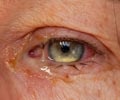The mystery of genetic disease is only partially solved with the identification of a mutated gene. Often, the pattern of disease – the features or disorders associated with it – vary in type and severity among those who are affected. Scientists, physicians and patients all ask why.
In this week's journal Nature Genetics, an international consortium of researchers, including some from Baylor College of Medicine, provide not only an explanation for the variations of vision loss in people with a host of disorders associated with defective cilia within the cells, but also a blueprint for unraveling similar variations in signs among people with other genetic diseases.In particular, this report deals with a variant of the gene RPGRIP1L (retinitis pigmentosa GTPase regulator-interacting protein-1 like), a ciliary gene mutated in at least two inherited diseases (Meckel-Gruber and Joubert syndromes). However, the researchers showed that, when people who have similar diseases that are caused by different gene mutations affecting the cilia also have a particular variant of this gene, they also suffer more severe degeneration of the retina – the light-sensing part of the eye – and lose vision.
"When you look at a disorder such as Bardet-Biedl Syndrome with multiple features – extra fingers and toes, retinitis pigmentosa (a vision disorder), asthma, obesity and kidney, you wonder how a single gene can interact or influence the expression of the other 25,000 or so genes that humans have," said Dr. Richard Lewis, professor of ophthalmology, medicine, pediatrics, and molecular and human genetics at BCM and an author of the report.
In Bardet-Biedl Syndrome, he and his collaborators first identified the fact that it takes three changes in gene copies to cause disease. So far, they have identified most of the 14 different mutated genes associated with the disorder. Most have something to do with the structure or function of cilia, he said.
Cilia are tiny hair-like structures that either move things along inside the cell or help with sensory activities.
"Anything that disrupts this elevator that runs things from one part of a cell to another has an effect on the severity of the disorder," Lewis said. Some mutated genes may alter the structure of the elevator shaft and the movement of the car up and down, but another gene could actually affect the speed at which the elevator moves, said Lewis. If the product of that gene varies also, then it affects the protein interaction and ultimately, the patient's ability to see.
Advertisement
Source-Eurekalert
SRM















